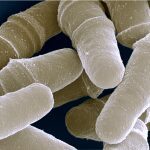Lien vers Pubmed [PMID] – 14765111
EMBO J. 2004 Feb;23(4):930-8
Mating-type switching in the fission yeast Schizosaccharomyces pombe is initiated by a strand-specific imprint located at the mating-type (mat1) locus. We show that the imprint corresponds to a single-strand DNA break (SSB), which is site- but not sequence-specific. We identified three novel cis-acting elements, involved in the formation and stability of the SSB. One of these elements is essential for a replication fork pause next to mat1 and interacts in vivo with the Swi1 protein. Another element is essential for maintaining the SSB during cell cycle progression. These results suggest that the DNA break appears during the S-phase and is actively protected against repair. Consequently, during the following round of replication, a polar double-strand break is formed. We show that when the replication fork encounters the SSB, the leading-strand DNA polymerase is able to synthesize DNA to the edge of the SSB, creating a blunt-ended recombination intermediate.

